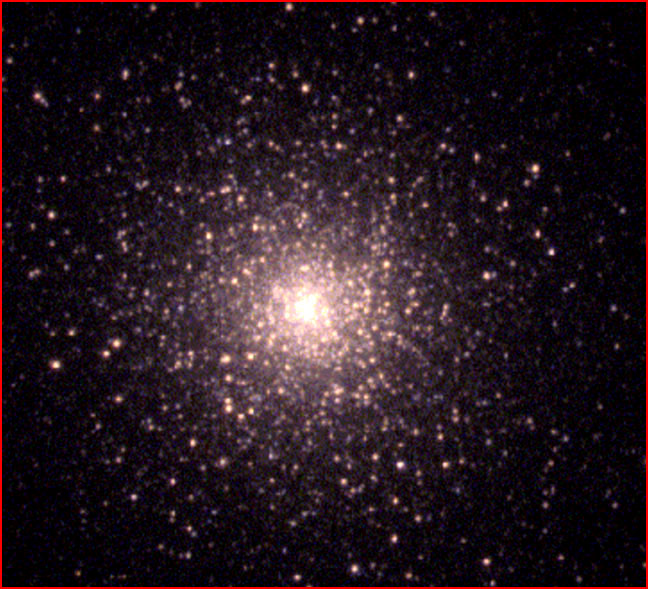
home •
about •
essential guide •
picture of the day •
thunderblogs •
news •
multimedia •
predictions •
products •
get involved •
contact

Credit: The Electronic Universe Project
pic of the day
archive
subject index
abstract
archive
Links:
Society for
Interdisciplinary
Studies

Thunderbolts of the Gods is a
108 page 8-1/2 x 11 full color monograph based on the life work of the two
authors--a revolutionary synthesis of comparative mythology and the
newly-discovered "Electric Universe".

The Monograph includes
an hour-long DVD introducing various aspects of the Electric
Universe explained by members of the Thunderbolts Group.
Dec 16, 2005
M15: A Great
Globular Cluster
Globular clusters are a particularly difficult problem for a gravity-only cosmology. They should not be where we see them, and their spherical configuration defies the expectations of standard theory.
Today, astronomers continue to wrestle with problems posed by exotic structures in space that appear to mock Newton’s elementary “laws”. In their attempts to account for unexpected galactic motions, astronomers have invoked invisible entities and forces: Black Holes, "dark matter" and "dark energy”, which are imagined to be far more powerful than anything actually seen. In stepping out on this lily pad, they have even speculated that as much as 99 percent of the matter in the universe is “dark” and can be measured only by “apparent gravitational effects”. It was this resort to unseen matter that caused Astronomer Halton Arp to observe in Seeing Red that "past 90% it [dark matter] begins to make observations irrelevant".
Within our own galaxy, the Milky Way, globular clusters or spherical configurations of stars such as M15 above, are a particularly difficult problem for a gravity-only cosmology. By what mechanical magic does gravity hold a million stars together in this way, as a sphere rather than the familiar disk of gravitational models? Gravitationally, spherical configurations of stars simply hanging in space are absurd.
The problem is heightened by the fact that M15 is only one of about 100 known globular clusters associated with the Milky Way. Strictly speaking they are not a part of our galaxy as traditionally defined. Rather they appear close to the core of the galaxy as a spherical “halo” above and below the center of galactic rotation.
Yet astronomers rarely acknowledge the dynamic problems this creates. Theory states that clusters above the plane must move on orbital paths around the center of the dynamic system as a whole, and in completing an orbit each will intersect the galactic plane twice. Such an intersection with the plane would induce tidal distortions and disrupt the cluster.
The problem was recently noted by the physicist C. Johnson of the University of Chicago, “It is almost like physicists have been assuming they [globular clusters] just hover there like a swarm of bees. But that wouldn't happen. They could NOT just follow elliptical paths above or below the Galactic Plane. Basic gravitational theory insists that their elliptical paths pass through the Galactic Plane, because the two halves of any path must be on opposite sides of that Plane”.
Johnson suggests that something is missing—and not a small piece of the puzzle. "It would appear that either our understanding of the Laws of Physics is sadly lacking, or our understanding of the geometry of the situation is greatly in error. The commonly accepted view of a halo of ancient, stable Globular Clusters hovering around the Core of the Galaxy, like a swarm of bees, is just not compatible with our current understanding of the Laws of Physics. Clearly, further research is necessary".
The same quandary applies to the relative motions of stars within each cluster. And while Johnson accurately describes the gravitational dynamic, the rule he applies is a formula for chaos. As any gravitational simulation will demonstrate, it would quickly lead to some stars being accelerated out of the system, while others would lose energy and fall to an orbit closer in. Over time, the globular clusters would largely "evaporate".
But from another vantage point, it is not unthinkable that the stars of globular clusters are “just hanging there”, both with respect to the clusters’ own center of gravity and the gravitational center of the galactic disk to which the clusters are symmetrically linked. In the electric universe model of stellar composition and energy, stars are concentrations of highly positive-charged material. For globular clusters, such a collection of stars with no other external distorting forces in play might indeed form a stable ball-of-stars formation. In fact, the new view of the universe provides many examples of star-sized masses—even galactic clusters—in symmetrical arrangements that gravitational theorists never dreamt of (including polar alignments). And as for the spherical form of globular clusters, the cosmic electricians suggest that the best analogy may come from something as unfamiliar to astronomers as ball lightning.
See: Jan 05, 2005
A Loose Cannon in Space
July 08, 2004
Driving Forces of the
Milky Way
Apr 15, 2005
Electric Motor of the Milky Way
July 23, 2004
Galaxy Filaments
July 14, 2004
NGC 1232
May 02, 2005
Plasma Galaxies
Jan 13, 2005
Seeing Circuits (2)
Nov 08, 2004
The Milky Way
Family
Contributed by Michael Armstrong
EXECUTIVE EDITORS:
David Talbott, Wallace Thornhill
MANAGING EDITOR:
Mel Acheson
CONTRIBUTING EDITORS: Michael Armstrong, Dwardu Cardona, Ev Cochrane,
C.J. Ransom, Don Scott, Rens van der Sluijs, Ian Tresman
WEBMASTER: Michael Armstrong
Copyright 2005: thunderbolts.info